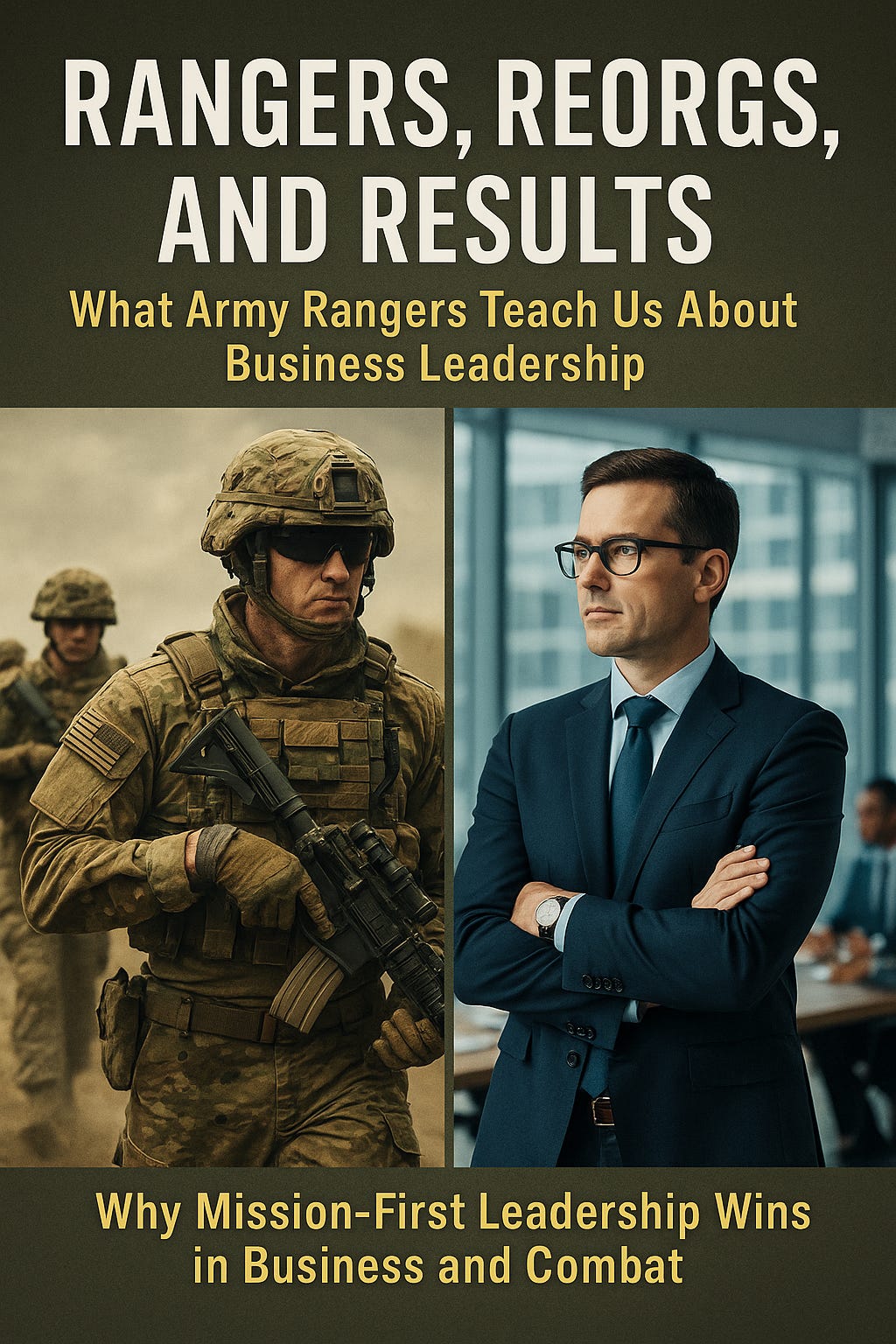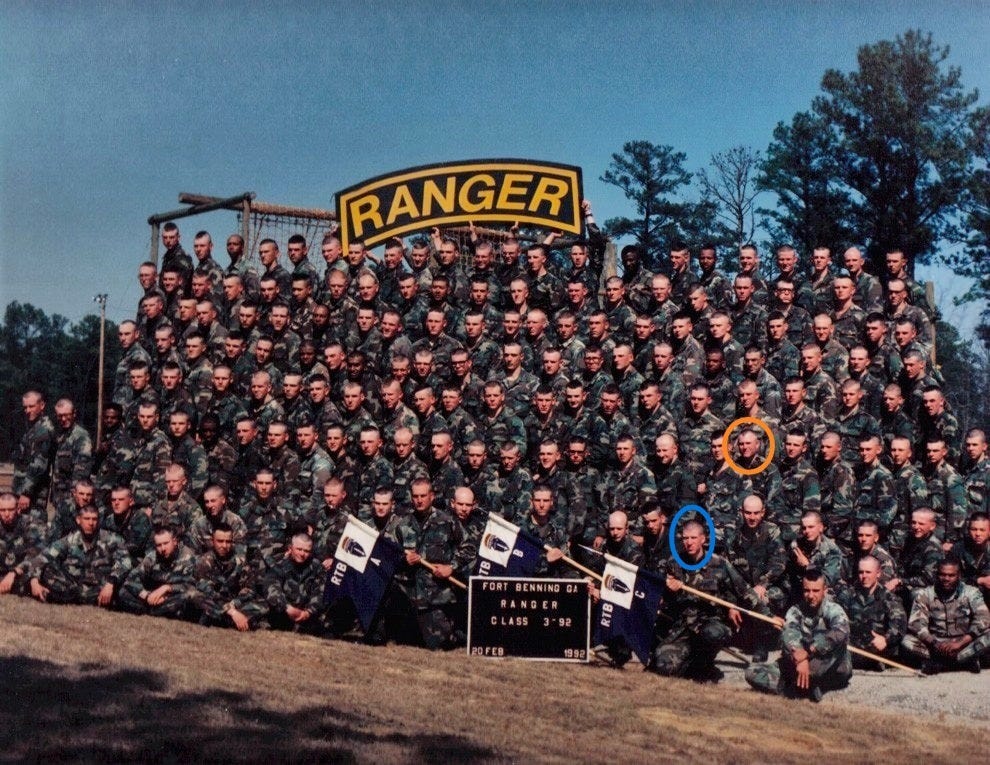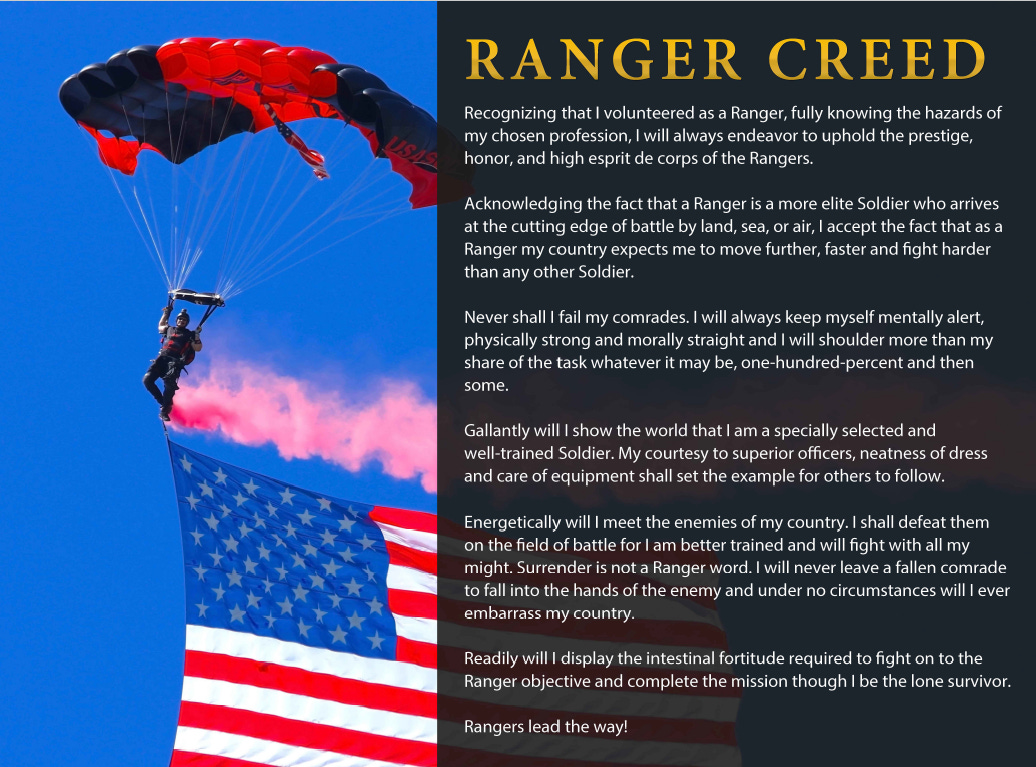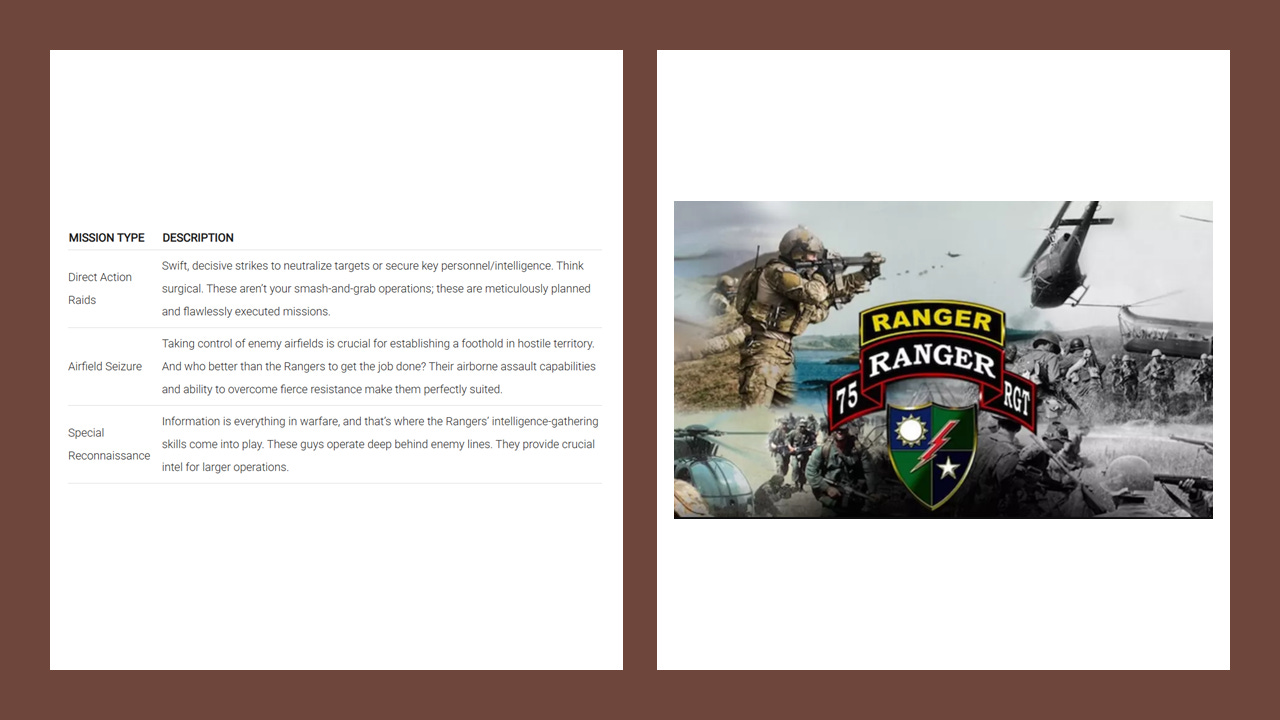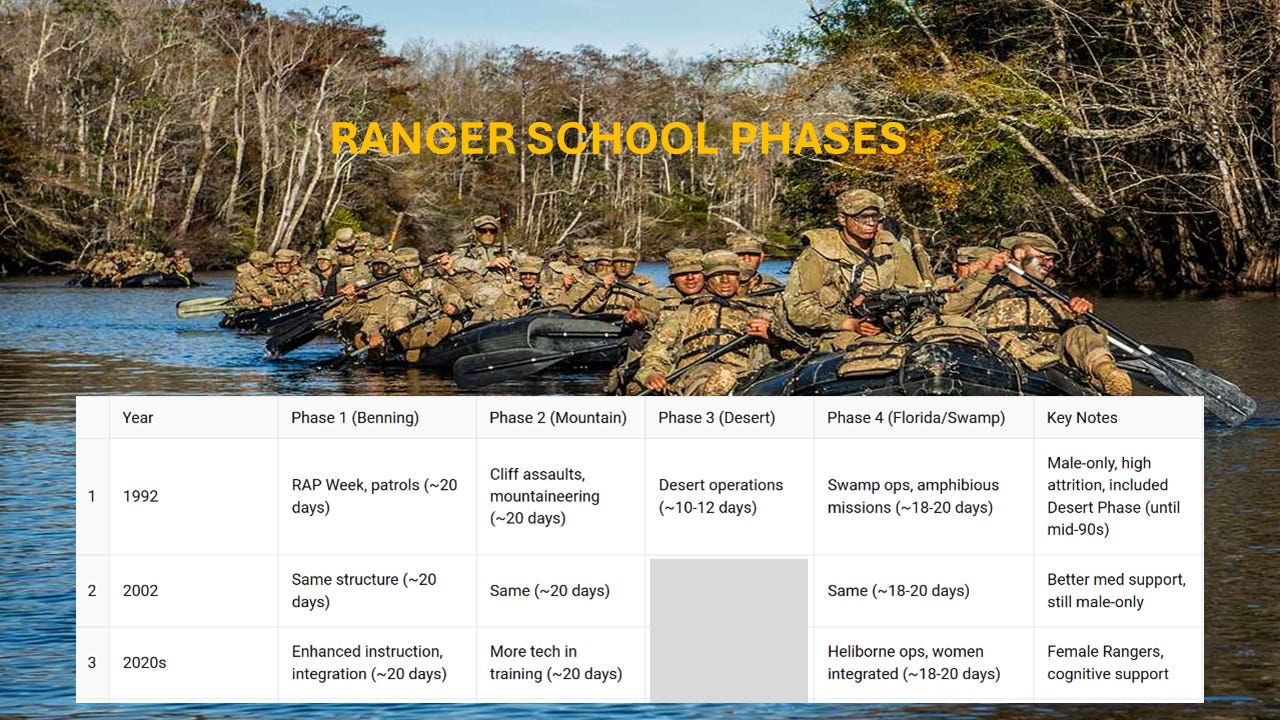Rangers, Reorgs, and Results: What Army Rangers Teach Us About Business Leadership
Why Mission-First Leadership Wins in Business and Combat.
Introduction
My first “real” exposure to U.S. Army Rangers was when I went through Ranger School as a young infantry officer. I heard the stories and what the training would be like. I felt very prepared mentally and physically to complete the program.
Fast forward to Day 1, Hour 1 in the School…well…I wondered, “What have I gotten myself into?” and was determined to go straight through and not spend one additional minute. I successfully adhered to that mantra and graduated.
Reflecting on the experience, it wasn’t what I would describe as “fun,” but life-changing. Sure, I carried a 100+ pound rucksack, slept 2-4 hours a night, hallucinated due to lack of sleep (yes…really), and lost 30 pounds.
Yet what I learned was that, foremost, the school is about leadership. It’s first learning how to follow so one can lead. It’s sharing everyday experiences and creating unmatched bonds. It’s understanding that the body can push as far as it needs, and training the mind to keep up and not to give in.
The battle cry “Rangers, lead the way!” first rang out during the D-Day landings in Normandy and became the Rangers’ enduring motto. Such principles are not just battlefield bravado; they translate powerfully into effective business leadership.
Many veterans and entrepreneurs have found that the values guiding a Ranger unit can drive success in the boardroom, especially in high-performance environments.
This summary distills key Ranger leadership tenets and shows how to apply them to business leadership, scaling teams, and mentoring others.
Each section provides insights and real-world examples relevant to business leaders, private equity professionals, and senior executives seeking an edge in leadership.
“Rangers Lead the Way!” – Leading from the Front
The core Ranger motto, “Rangers Lead the Way,” means that Ranger leaders go first into the most challenging missions, setting an example of courage and initiative.
In practice, no Ranger leader would ask their team to take on a challenge they are unwilling to tackle themselves. This ethos of leading from the front builds enormous trust and credibility, whether on the battlefield or in business.
Great business leaders roll up their sleeves and set the example for others. For instance, a CEO might join sales calls or work alongside frontline teams during a crisis, demonstrating commitment.
An example of this is Howard Schultz, the former CEO of Starbucks. During tough times, Schultz visited stores, worked behind the counter, and spoke directly with baristas. His approach? “You have to be present to make the right calls.”
By being present where the hard work is done, leaders inspire their people to push harder and “follow them up the hill,” just as Rangers rally behind officers charging up a bluff.
So, what is the Business Application? Leading from the front in a company means visibly taking initiative on challenging tasks and being first to embrace change. Instead of issuing directives from a corner office, effective executives engage directly with challenges and model the behaviors they expect:
Set the example: Show exemplary work ethic, ethics, and resilience in day-to-day operations. As the Ranger Creed says, “My care of equipment shall set the example for others to follow”, meaning leaders maintain high standards themselves.
Share the risks and burdens: Just as Rangers share hardships in training, business leaders should partake in the “grunt work” during high-pressure projects. This signals that no job is beneath the leader and that the mission is a shared endeavor. In my view, titles are for external benefit only.
Earn trust through action: When teams see leaders navigating obstacles at their side, it creates trust and loyalty. Employees are likelier to go “all in” when their leaders visibly lead the way through uncertainty.
Real-world examples abound. During the 1944 Normandy invasion, Army Rangers followed General Norman Cota, who personally moved among frontline troops under fire, urging “Rangers, lead the way!”.
In the business world, this same ethos is reflected by CEOs who stay “right up with the lead platoons” of their company during tough times, actively guiding and motivating teams rather than commanding from afar. The result is a culture where initiative and bold leadership become contagious at every level.
“No Excuse Leadership” – Extreme Ownership and Accountability
Army Rangers operate in an environment where excuses don’t save lives or accomplish missions. The phrase “No Excuse Leadership” has become shorthand for the Ranger expectation that leaders accept complete responsibility for outcomes and never blame circumstances.
In Ranger School, candidates are pushed beyond their limits on minimal food and sleep, yet failure is not met with sympathy but with the credo: leaders don’t make excuses!
They learn to improvise, adapt, and overcome obstacles with sheer determination. This culture of accountability translates directly to high-performance business teams.
In business leadership, “no excuses” means fostering a mindset of extreme ownership, taking responsibility for results, and focusing on solutions instead of blame.
Challenges such as market downturns, supply chain failures, or aggressive competitors are approached the same way a Ranger unit approaches a formidable objective: with resolve and creative problem-solving rather than defeatism.
A former Ranger described this mentality succinctly: “No-excuse leaders don’t have to act tough, but they must display mental toughness”. That mental toughness in business looks like pushing through adversity (tight deadlines, budget cuts, failed deals) by finding a way to do the job without complaint.
Importantly, a no-excuses culture starts at the top. Leaders who own their decisions, good or bad, set a powerful example for their teams. Companies run by leaders with military backgrounds (steeped in accountability) often outperform their peers.
One study found that companies led by ex-military CEOs outpaced the S&P 500 and had longer CEO tenures, suggesting that this no-excuses leadership style yields tangible results.
For example, many veterans-turned-CEOs institute “no blame” policies if a project fails; the focus is on learning and fixing the issue, not excusing it or pointing fingers. This encourages candor and rapid problem-solving.
This also means that leaders “lean in” to a problem and do not excuse it away. I’ve seen this a few times in my career, and, in the end, the business and morale suffer.
Tech executive Dan Streetman (I’ve spoken with him a few times), a former Army Ranger, West Point graduate, and now CEO of a cybersecurity firm, argues that leaders must combine confidence with humility, owning up to mistakes while remaining determined to correct course.
By admitting errors plainly and refusing to hide behind excuses, leaders build credibility and a culture where the team likewise takes ownership of problems.
In summary, No Excuse Leadership in business creates an environment where goals are met through responsibility and resilience, not rationalization, much like a Ranger unit holding themselves to the mission no matter the challenges.
“Never Leave a Fallen Comrade” – Loyalty and Team Cohesion
Rangers live by an unwavering code: “I will never leave a fallen comrade to fall into the hands of the enemy”. This commitment to loyalty and mutual support means that every Ranger knows their team will go to great lengths to protect and aid them.
In combat, it’s literal rescuing wounded teammates, but the principle extends to morale and trust. Translated to business, never leaving a teammate behind means fostering a culture of support, mentorship, and “got your back” camaraderie.
Rather than a cutthroat environment where underperformers are cast aside, high-performing organizations often echo this Ranger principle by investing in people and helping them improve.
Former Army Ranger and CEO of Conquer Academy Jeramiah Solven notes that Rangers “protect each other on the battlefield and never leave a man behind, loyalty and teamwork principles which executives can use to create amazing team culture and employee satisfaction on the battlefield of business”.
In practice, business leaders can implement this by ensuring no team member faces overwhelming challenges alone. For example, if a project is in trouble, the whole team rallies to fix it rather than isolating or blaming one individual.
Accountability in a Ranger-like culture is a two-way street: leaders hold people to high standards and provide them the support and resources to meet those standards.
Real-world case: Ahmed R. Ali, a military veteran CEO, grew his tech company TISTA from 1 to about 700 employees by emphasizing a “people-first” culture.
He explains that “you can’t succeed in the military without taking care of your battle buddy, and no leader in any environment can succeed without team members who look out for each other”.
At his company, new hires go through a rigorous onboarding (their “basic training”), and once they’re part of the team, the focus is on building them up for the long term. This reflects the Ranger approach of bringing every member up to elite standards and never giving up on each other.
The result? High loyalty and lower turnover, much like a Ranger unit, the team becomes a tight-knit force where everyone trusts that others will cover their blind spots and help them grow.
For leaders in private equity or fast-scaling companies, this principle is especially relevant: as teams expand, scaling culture and preserving trust are paramount.
Ranger-style loyalty can be instilled by: (1) Mentorship programs (pair new team members with experienced “battle buddies” for guidance), (2) Team-based problem solving (no one left to struggle alone), and (3) Recognition of group wins (celebrating how the team pulled together).
By never leaving anyone behind, leaders create a unified team prepared to tackle ambitious goals, knowing every member has backup. As one veteran put it, “take care of your soldiers and they will take care of you… in the job and outside the job, this practice never fails”.
“Sua Sponte” – Initiative and Empowerment at All Levels
A distinctive Ranger principle is captured in the 75th Ranger Regiment’s Latin motto “Sua Sponte,” meaning “Of their own accord.” In essence, every Ranger is expected to take action proactively, even without explicit orders.
This reflects a culture where initiative, adaptability, and decentralized decision-making are highly prized. In the fast-moving scenarios Rangers face, waiting for instructions can be fatal; similarly, in business, front-line employees and junior leaders often have the best information to make quick decisions. Empowering them to act can be a game-changer for agility and innovation.
In military terms, Sua Sponte means each Ranger sees themselves as a leader responsible for the mission’s success. They are trained to understand the commander’s intent and then use their judgment to accomplish the task.
One leadership commentator described it as pushing decision-making authority to the front lines: Rangers “take action on their own initiative, without waiting for orders or direction from above… based upon their training, [they] respond appropriately”. This is analogous to what modern management gurus call empowering the edge or decentralized leadership.
Business Application: Companies that embrace a Sua Sponte-like ethos encourage employees at all levels to exercise judgment and initiative in service of the company’s goals. Instead of a hierarchical bottleneck where all decisions wait for executive approval, these organizations practice trust and empowerment:
Leaders communicate a clear vision and values (the business equivalent of a commander’s intent, which everyone should know).
Within that framework, team members are entrusted to make decisions and solve problems immediately, using their training and best judgment.
Managers act more as coaches and mentors than micromanagers, knowing that the person on the ground often can “find a way to get it done” without seeking permission for every minor move.
The payoff is speed and adaptability. For example, if a customer issue arises, a frontline employee in a Sua Sponte culture wouldn’t wait for three layers of approval to appease the client; they would take ownership to resolve it in real time (much like a Ranger adjusting to on-the-ground realities).
Companies like Zappos, famed for innovation, use this principle by giving teams autonomy to execute on goals, trusting that people closest to the problem will act in the company’s best interest.
This principle also plays into scaling: as an organization grows, leaders cannot personally make every decision. Training your “troops” to think and act independently is crucial.
A high-profile illustration is the “Team of Teams” approach popularized by retired General Stanley McChrystal (a former Ranger), which argues that pushing decision-making power downwards and enabling small, agile teams to lead is the key to succeeding in complex, fast-paced environments.
In short, empowering initiative at all levels, the Ranger way creates a leadership multiplier effect in business, turning your entire team into confident problem-solvers rather than order-followers.
Mission Planning and Preparation – “Train as You Fight”
Another Ranger leadership hallmark is meticulous planning, training, and contingency preparation. Rangers famously say, “If you fail to plan, you can plan on failing.”
In Ranger operations, every mission is preceded by exhaustive planning sessions, rehearsals, and “what if?” scenario planning. As Keni Thomas, a former Army Ranger from the Black Hawk Down mission, recounted, success under pressure came from rigorous preparation:
“We do the planning in advance. We come up with the what-ifs, the contingencies, and the contingencies for the contingencies… You implement your practice. You train as you fight and fight as you plan.”.
In other words, Rangers practice for chaos so that when chaos comes, they execute with calm discipline.
In business, too, high-stakes situations (major product launches, negotiations, crises) reward those who have planned and drilled ahead of time. Effective leaders adopt the Ranger mentality of never winging it on critical missions.
This can mean instituting robust strategic planning processes, running simulations or scenario drills, and ensuring teams are well-trained in their roles. For example, a sales team might role-play tough client negotiations (contingency: what if the client pushes back on price? what if tech issues arise during the pitch?).
Tech companies often conduct “game day” exercises to test their systems’ resilience by simulating outages directly parallel to the military training for worst-case scenarios. The Ranger credo “you can’t phone in the practice” applies here: peak business teams train hard so real performance is sharp.
No elite sports team or military unit skips practice; likewise, the best businesses invest in employee training, dry runs, and playbooks for various scenarios.
Additionally, Ranger planning emphasizes clarity of mission and roles. Everyone knows the objective and their part in achieving it, even if plans change on the fly. In a corporate context, this suggests that leaders should communicate mission objectives clearly and ensure each team member understands how their work contributes to the bigger picture.
When unexpected challenges hit, a key employee leaves, a supply chain breaks, a well-prepared team can reorganize quickly because they’ve internalized the mission and practiced adaptability.
The famous saying “no plan survives first contact with the enemy” holds true in business, too, but Rangers mitigate that by planning thoroughly and being ready to pivot when needed.
As seen on D-Day, when plans went awry, Ranger leaders improvised effectively because they understood the mission intent and had rehearsed different contingencies.
Business leaders who emulate this by doing their homework, training their teams, and staying flexible will navigate turbulence far more successfully than those who rely on hope or rigid plans alone.
Decisiveness Under Pressure – Staying Calm and Taking Action
High-performance environments, whether in combat or business, inevitably face crisis moments when something goes wrong and panic looms. Rangers are trained that when the unexpected happens, “when things go wrong, don’t stand around.” They must make decisions and lead, even amid uncertainty or fear.
Keni Thomas recalls that when a Black Hawk helicopter was shot down in Mogadishu, the worst instinct would have been to freeze or say, “This isn’t my job.” Instead, Rangers stepped up to contain the situation.
“Panic makes you want to save yourself, but saving yourself leaves other people hanging,” Thomas explains. “Leadership is a choice we make on a daily basis to do the right thing… You can’t stall and hope things work themselves out. You have to be proactive. It is your job to make sure that the people to your left and right get out, that they are protected.”.
In these words, we hear the Ranger emphasis on calm, selfless action in a crisis – focusing on the mission and the team, rather than one’s own fear or confusion.
In the business arena, leaders frequently confront their own “Black Hawk down” moments: a sudden loss of a major client, a PR fiasco, a cyber-attack, or any shock that threatens the organization.
A Ranger-trained mindset is incredibly valuable here. Rather than falling into paralysis or casting blame, an effective leader will maintain calm, assess the situation clear-headedly, and rally the team to respond.
This could mean quickly convening a crisis team, communicating transparently with stakeholders, and providing reassurance to employees. The ability to “not give up on you,” as Lt. Col. Walter Sorensen says of Ranger-qualified leaders in business terms, not abandoning the team or mission in a tough moment, can be the difference between failure and recovery.
A practical example is the way some companies handle outages or emergencies through pre-appointed incident leaders who immediately take charge to fix the issue, while others coordinate support, akin to how a Ranger unit has contingency leadership when an officer is down.
This prevents chaos and instills confidence that someone is at the helm. Additionally, Ranger-trained individuals often speak of “detachment,” the practice of taking a mental step back to survey the battlefield.
Business leaders can do the same under pressure: pause, gather facts, prioritize actions (which fires to put out first), then execute decisively. The credibility built from previous principles, leading by example, loyalty, and no excuses, pays off here: teams are far more likely to follow a leader into the fire if that leader has proven their steadiness and commitment.
In sum, adopting Ranger-like decisiveness and composure under pressure means choosing action over paralysis, and focusing on collective success (“get everyone out safely”) rather than self-preservation. That approach steadies organizations in storms and often turns potential disaster into a story of resilience.
Mentorship and Team Development – The “Ranger Buddy” System
One of the less heralded Ranger practices is the “Ranger Buddy” system. In Ranger School and in Ranger units, soldiers are paired with a buddy to train, problem-solve, and keep each other going through hardship.
Ranger Buddies share everything from carrying heavy gear to keeping each other awake on overnight missions. This concept teaches a powerful lesson: no one succeeds alone. “Everyone needs a Ranger Buddy to provide counsel, to be a listener, or to challenge us to push farther than we otherwise could do alone,” writes a Ranger School graduate.
In military life, this means your partner might literally save your life or motivate you to persevere when you’re exhausted. In business, the principle translates to mentorship, coaching, and peer support as critical drivers of performance.
For an executive audience, consider how a Ranger-buddy mindset can improve team scaling and talent development. When a new team member joins, assigning them a seasoned “buddy” or mentor can accelerate onboarding and ingrain the company’s values (much like a veteran Ranger imparts lessons to a rookie).
This is akin to creating a “force multiplier.” Two people working in tandem can achieve more than the sum of their parts because they learn from and reinforce each other. Senior executives in private equity or high-growth companies often pair up with strong operational partners or advisors in a similar fashion, ensuring no leader goes it alone when making tough strategic decisions.
Additionally, encouraging peer-to-peer coaching within teams, where colleagues regularly check each other’s work, share feedback, and push each other to improve, builds a culture of continuous learning. It echoes the Ranger sentiment that “we all need the encouragement and accountability that comes from a buddy”.
Real-world evidence of this principle is seen in many top companies that implement formal mentorship programs or “buddy systems” for new hires and for leadership development. For example, at Microsoft, new employees are often assigned an onboarding buddy to show them the ropes.
At consulting firms and investment banks, it’s common to have a more experienced colleague guide analysts or associates through their early projects. These practices reduce ramp-up time and prevent avoidable mistakes, just as a Ranger buddy prevents his partner from unknowingly stepping into danger.
Moreover, a culture that prizes mentorship tends to retain talent better, because people feel invested in and supported. Dan Streetman, the Ranger-turned-CEO, has displayed this by passionately mentoring veterans transitioning into tech careers.
Through initiatives that train and place former service members, he is extending the Ranger ethos of “never leave a comrade” into a form of professional mentorship beyond his company. The takeaway for business leaders is clear: to scale high-performance teams, develop leaders at every level by pairing people up, sharing knowledge, and holding each other accountable to grow.
A Ranger unit’s strength is not just in a few star individuals; it’s in the tight fabric of mentorship and mutual accountability that holds the group together. The same is true for world-class business teams.
Conclusion – From the Battlefield to the Boardroom
The leadership principles honed by Army Rangers have proven remarkably transferable to competitive business environments. It’s no coincidence that many military veterans thrive in corporate leadership roles. The values of discipline, teamwork, accountability, and courage under pressure are universally effective when adapted thoughtfully.
As we’ve seen, Ranger-inspired leadership means leading from the front, owning results with no excuses, building a loyal team culture, empowering people to act with initiative, planning and training hard for any scenario, staying calm and decisive under fire, and lifting others through mentorship.
For business leaders, private equity professionals, and executives, these concepts offer a roadmap to scaling organizations that are not only high-performing but also resilient and cohesive. A culture built on Ranger principles will likely exhibit strong trust, rapid decision-making, and an unyielding focus on the mission qualities that give companies an edge in turbulent markets.
As one Ranger-turned-executive observed, “The proficiency of your people and systems is directly proportional to the level of success you will have in business… you must have the right team members who can work together, protect each other, and hold each other accountable”. In other words, long-term business success isn’t just about having a great strategy or product; it’s about forging a team with Ranger-like excellence and unity that can execute that strategy.
By adopting mottos like “Rangers Lead the Way!” as a daily leadership reminder, executives can inspire their organizations to be bold and proactive. By insisting on “No Excuse” accountability, they set a standard that lifts performance.
By committing to never leaving anyone behind, they cultivate loyalty that money can’t buy. These lessons, born in Ranger School’s grueling trials and in real battles, can become a source of competitive advantage in the business world.
Just as Rangers train to fight on to the objective, “though I be the lone survivor”, corporate leaders guided by grit and principle can persevere through business adversity to achieve their mission. In summary, Army Rangers lead the way, and by internalizing their leadership principles, so can you in your industry.
Sources
Insights and data in this newsletter are drawn from publications and research, including:
Army Ranger Creed and Ethos – U.S. Army Ranger Creed (Army.mil)
Dustin Siggins, “From Iraq to the Corner Office: Army Ranger Principles For Running Your Business,” Zenger News (syndicated, Oct 2021)
Brace E. Barber, No Excuse Leadership: Lessons from the U.S. Army’s Elite Rangers (John Wiley & Sons, 2004) – via J. Flinchbaugh summary and RangerSchool.com
Keni Thomas keynote leadership lessons – GovLoop (Oct 2014)
Tom Magness, Leader Business blog – “Rangers Lead The Way” I & II (2009)
Entrepreneur Magazine – William Salvi, “The Most Important Traits Are Confidence and Humility: Leadership Lessons from an Army Ranger Turned CEO” (Feb 2025)
USO.org – Ret. Maj. Gen. John C. Raaen Jr., “Rangers Led the Way on D-Day” (June 2019)
Indo-Pacific Command News – “‘Rangers Lead the Way!’ Airmen Cultivate Leadership Qualities…” (July 2019).
Forbes (via New Orleans Data News Weekly) – “Army Ranger Principles for Running Your Business”.



